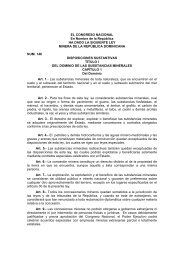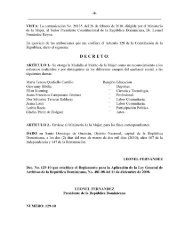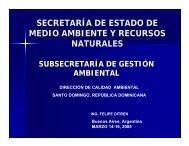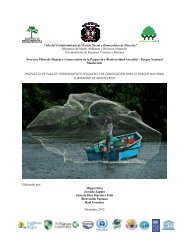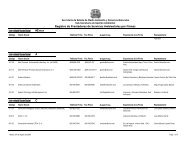CAMBIO CLIMATICO
CAMBIO CLIMATICO
CAMBIO CLIMATICO
You also want an ePaper? Increase the reach of your titles
YUMPU automatically turns print PDFs into web optimized ePapers that Google loves.
REPÚBLICA DOMINICANA 2003<br />
1.1.3 Seas, Coasts and Island Areas<br />
The coastal border measures 1,575 km, of which<br />
824 are on the Atlantic Coast and 752 on the<br />
Caribbean Coast; of the total, 1,478 km belong to<br />
the island and 97 km to the keys and smaller<br />
islands. Of the 48,670.82 km2 of the total area<br />
of the country, 56.5% corresponds to the coastal<br />
provinces and their numerous keys and small<br />
islands, that is, 27,437 km.<br />
The main coastal marine ecosystems in the<br />
Dominican Republic occupy 66,160 hectares, of<br />
which 8,940 are mangroves, 18,600 are marine<br />
grasslands, 13,300 are coral reefs, and 24, 420<br />
are beaches.<br />
1.1.4 Temperature<br />
The Dominican Republic falls within an annual<br />
median isotherm of 25° C, making it 1.5° C<br />
milder than the temperature for its latitude, due<br />
to the maritime influence and the breezes. The<br />
mean annual temperatures range from 17.7° C in<br />
Constanza, at an altitude of 1,234 meters, to<br />
27.7° C at 10 meters above sea level. The mean<br />
monthly temperature ranges between 15.4° in<br />
Constanza and 30.6° C in Duvergé, at two meters<br />
above sea level. The temperature decreases as<br />
the mountainous terrain rises.<br />
The decrease is approximately 0.5° C per each 100<br />
meters. This explains why Santo Domingo, at sea<br />
level, has a mean annual temperature of 25.6° C<br />
and Constanza, at 1,234 meters above sea level, has<br />
a mean annual temperature of 18° C. The lowest<br />
temperatures are registered during the winter but<br />
never go below 15° C. However, during the summer<br />
the temperature can reach 34° C at midday.<br />
1.1.5 Climate<br />
The variable climate is due to the latitude, insularity,<br />
proximity to large bodies of water and<br />
land masses, the temperature of the neighboring<br />
seas, the dominant east winds (the trade winds<br />
from the northeast), the pressure system, the<br />
island terrain and hurricanes.<br />
The equatorial currents from the north and<br />
south affect the country due to their high temperatures<br />
and water content, contributing to the<br />
intensification of these characteristics of our climate.<br />
On the other hand, our relative nearness<br />
to North America puts us in the reach of the<br />
large cold air masses that descend in winter over<br />
the central plains of the United States and that,<br />
on arriving in our country, bring low temperatures<br />
and rain, a phenomenon known as “the<br />
North.” But no less important is the varied terrain<br />
of the island that determines important<br />
local variations, such as significant daily fluctuations<br />
in the various meteorological elements<br />
and the tropical hurricanes that are associated<br />
with strong winds that can reach more than 200<br />
km/h, and torrential rains with an intensity<br />
above 500 mm/24 hours, occurring mainly from<br />
August to October and affecting principally the<br />
southwestern part of the country.<br />
1.1.6 Rainfall<br />
The mean annual rainfall for the entire country<br />
is 1,500 mm, with variations ranging from 350<br />
mm in the basin known as Hoya de Enriquillo to<br />
2,743 mm annually in the Cordillera Oriental, or<br />
Eastern Mountain Range. It is important to note<br />
that more than half of the country enjoys more<br />
that 100 days of rain annually, with variations<br />
ranging from 31 days in Pedernales to 265 days<br />
in San Cristóbal.<br />
The terrain or topography produces what is<br />
known as orographic rains, which occur in four<br />
places in the country: 1) the coast of Samaná<br />
and Escocesa Bays, from Cabrera to Miches; 2)<br />
the northern slope of the Cordillera<br />
Septentrional, or Northern Mountain Range,<br />
from Puerto Plata to Gaspar Hernandez; 3) the<br />
eastern part of the Cordillera Central, or Central<br />
Mountain Range, from Jarabacaoa to San<br />
Cristobal; and 4) the eastern part of the Sierra de<br />
Bahoruco, or Bahoruco Mountain Range, to the<br />
south of Barahona.<br />
When the humid trade winds encounter a mountain<br />
in their path, they are forced to rise; with<br />
40


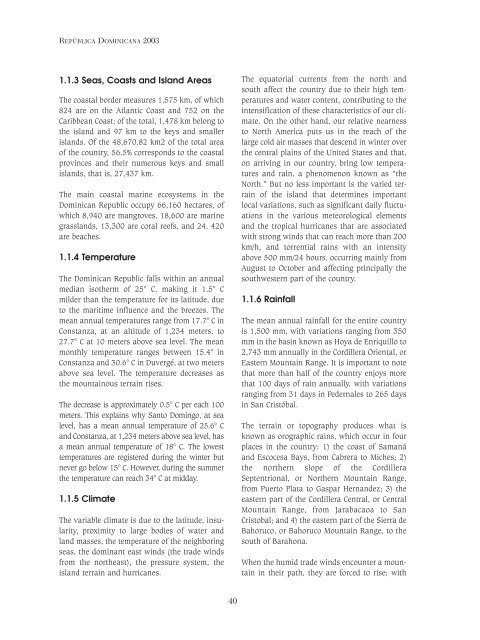
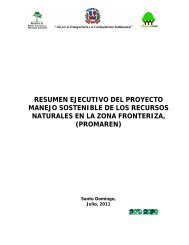
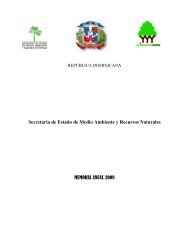

![Documento de trabajo del grupo G-77[1] EconomÃa verde en el ...](https://img.yumpu.com/50859069/1/190x245/documento-de-trabajo-del-grupo-g-771-economa-a-verde-en-el-.jpg?quality=85)




